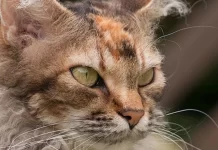Last Updated on August 26, 2023 by Fumipets
Turkish Angora: A Summary of Elegance and Grace
The Turkish Angora cat, with its striking appearance and graceful demeanor, holds a special place in the hearts of cat enthusiasts around the world. Originating from Turkey, this breed is characterized by its luxurious coat and captivating personality. Let’s explore the world of Turkish Angora cats and uncover their intriguing characteristics in this summary.
Turkish Angora
The Turkish Angora, which is well-liked in its native Turkey, is maybe the only domestic cat reared and housed in a zoo. These stunning, perceptive, and royal cats were all mistakenly believed to be deaf (more on that later), and they were utilized so often in crossbreeding to develop the Persian breed that they were all but exterminated. Turkish Angora cats are beloved by individuals who seek a silky, alluring long-haired cat despite the fact that they are still an uncommon breed today.
Appearance
According to the breed standard, the Turkish Angora is a medium-sized cat with a thin, delicate look. All Angoras have a dignified, royal personality and conduct themselves with elegance, while those that come from the Ankara Zoo in Turkey have a somewhat larger frame.
The angora coat is exceptionally silky, lengthy, and available in a broad range of hues. Turkish Angoras come in a variety of colors, while white is usually the most common and the only shade produced at the Ankara Zoo. Other colors include black, reds, browns, and grays, as well as tabby, tortoiseshell, and bicolor varieties.
Their tiny, rounded heads are adorned with huge, almond-shaped eyes that may be amber, green, blue, or heterochromatic pairs of blue/amber or blue/green, as well as wide-set ears.

Temperament
The Turkish Angora is a very smart animal. According to Pam Nichols, DVM, president of the American Animal Hospital Association, they are very sociable cats that form great ties with their family groupings, albeit they often pick one person in particular to associate with most closely.
Turkish Angoras like vigorous play, whether it is with their human friends or alone themselves. They can be occupied with a variety of toys, and due to their independence, they can also function well if left alone for a short period of time.
The Turkish Angora has a genetic tendency for deafness. The Cat Fanciers’ Association states that deaf Angoras live normal, healthy lives and that this doesn’t seem to have an impact on their quality of life. However, since they are unable to modulate and cannot hear their own voices, they may speak louder than usual.
Living Needs
If properly socialized, Turkish Angoras may get along with kids, however, very young kids should be warned from yanking their long hair or tugging on tails. According to Nichols, they are not as tolerant of being handled by young children as certain other breeds, such as the Himalayan.
If properly introduced, an angora will gladly tolerate other cats as well as dogs. However, they often function just as well on their own and, when left alone, don’t typically display many stress-related behaviors.
Turkish Angora cats, like other cats, need a range of toys as well as a few scratching posts to keep them entertained and prevent damage to furniture. They often perch in lofts, so provide them with a high perch from which they can see the house.
They like sitting in high places and “tend to be climbers,” according to Nichols.
Your Angora will prefer a high cat hammock, mounted cat shelves, or a tall cat tree. If a lofty seat isn’t provided, they’ll probably commandeer one on top of a bookshelf or door.
Care
The Turkish Angora’s long, silky coats have no undercoat, which makes grooming them pretty simple. However, this does not excuse you from grooming, since they need brushing one or two times every week to maintain their attractive coats. Although their hair is thin enough to not clump or mat all that readily, it will continue to grow until they are around 2 years old, so as your cat gets older, anticipate the brushing sessions to get more complex. According to Nichols, Turkish Angoras also shed a lot, so regular brushing will prevent their stray hair from getting on your furniture.
It will be crucial to keep an eye on their ears and the region around their eyes since the longer hair there might trap debris that could result in an illness. Any accumulation around the eyes and ears should be easily removed with a moist cloth.

Health
It was long believed that all Turkish Angoras were deaf throughout the 19th century and before. Although it is undoubtedly not the case, it is a more serious problem in this breed than in others. The breed’s hearing seems to be linked with the gene for white fur and blue eyes. Therefore, the likelihood of becoming deaf is greater than usual among white cats with blue eyes. This possibility also applies to cats with unusual eyes, with the side with the blue eye being deaf.
Some Turkish Angora kittens have an uncommon yet deadly illness called hereditary ataxia. Ataxic kittens exhibit trembling movements and do not live to maturity.
Hypertrophic cardiomyopathy, a heart disorder often occurring in male cats between the ages of 2 and 6, is another hereditary disease that is uncommon but well-known within the breed.
Although hypertrophic cardiomyopathy is treatable, a cat with HCM will eventually likely have cardiac failure, according to Michelle Beck, DVM, CCRT, CVA, of the Backlund Animal Clinic in Omaha, Nebraska. “The lifespan for congestive heart failure is typically about a year after detection.”
In addition, according to Nichols, the Turkish Angora may develop chronic kidney disease (CKD), which is characterized by a progressive decrease of renal function over time. The Cornell Feline Health Center claims that although there is no cure, there is therapy.
History
Some of the earliest cats tamed in the Fertile Crescent of the Middle East were the wild relatives of the Turkish Angora. An ancient breed, Europeans first became aware of them in the 16th century, when their beautiful white, long-haired coats made them sought as breeding material for the more well-known Persian.
By the end of the 19th century, this outbreeding procedure had become so widespread that it had almost driven the Angora to extinction, as their own lineages had been neglected in favor of bolstering the Persian’s. According to the TABC, early 20th-century collectors of white Angoras for breeding and preservation at the Ankara Zoo were responsible for saving the Turkish Angora from extinction. Since then, the zoo has produced and nurtured Angoras, but it wasn’t until breeding couples started traveling to Canada and the US in the 1960s that the zoo started selling cats for export outside of Turkey.
Turkish Angoras are still an uncommon breed today, but in 1973, the Cat Fanciers’ Association approved them for championship competition. All Angoras that are registered must still be able to prove their ancestry as coming from the Ankara Zoo.
Questions & Answers
1. What is a Turkish Angora cat?
The Turkish Angora is a breed known for its long, silky coat, striking color patterns, and captivating blue or amber eyes. Their elegant and agile nature adds to their allure.
2. What are the distinctive traits of Turkish Angora cats?
Turkish Angoras have a fine-boned structure, a plumed tail, and a variety of coat colors and patterns. Their sociable and playful personalities make them cherished companions.
3. How do Turkish Angora cats adapt to different environments?
These adaptable cats thrive in various environments, from busy households to tranquil settings. Their affectionate nature allows them to form strong bonds with their human families.
4. What kind of grooming do Turkish Angora cats require?
Due to their long coat, Turkish Angora cats benefit from regular grooming to prevent matting and tangles. Brushing their coat a few times a week helps maintain its beauty.
5. How do Turkish Angora cats interact with children and other pets?
Turkish Angoras are known for their gentle nature and willingness to interact with children and other pets. Proper socialization ensures harmonious relationships in multi-pet households.
Turkish Angora Cats: Living Works of Art
Turkish Angora cats embody elegance and grace, resembling living works of art that enchant all who encounter them. Their unique beauty, combined with their affectionate and intelligent personalities, makes them a cherished addition to homes where their allure is appreciated. From their luxurious coats to their engaging personalities, Turkish Angora cats continue to captivate and inspire cat lovers worldwide.


















